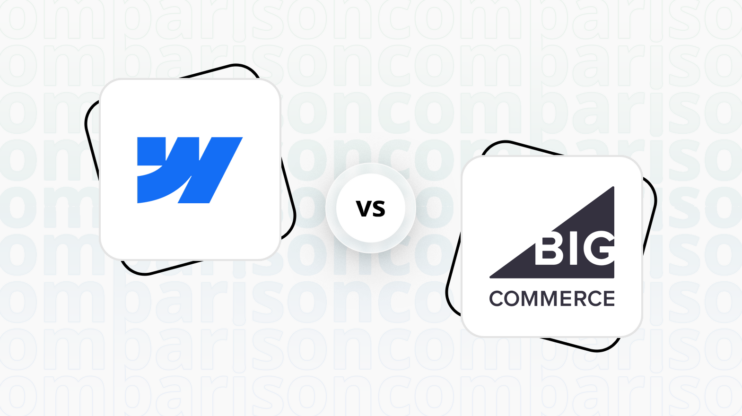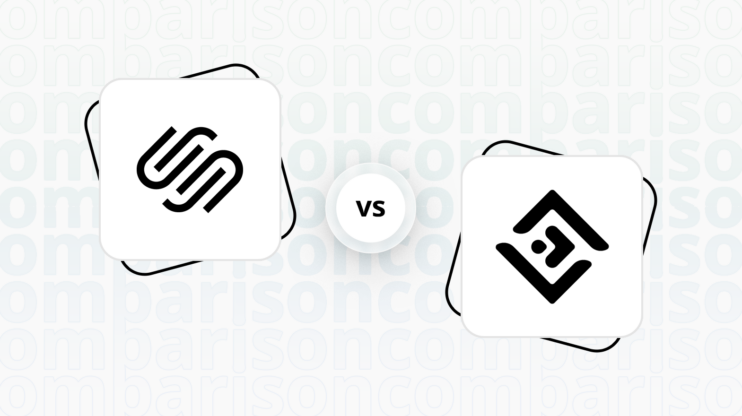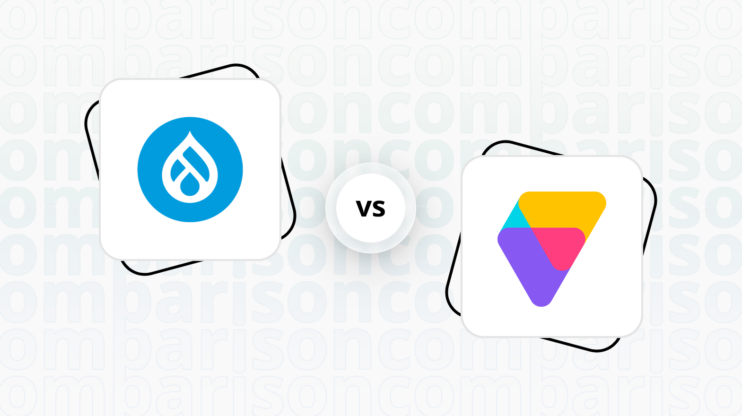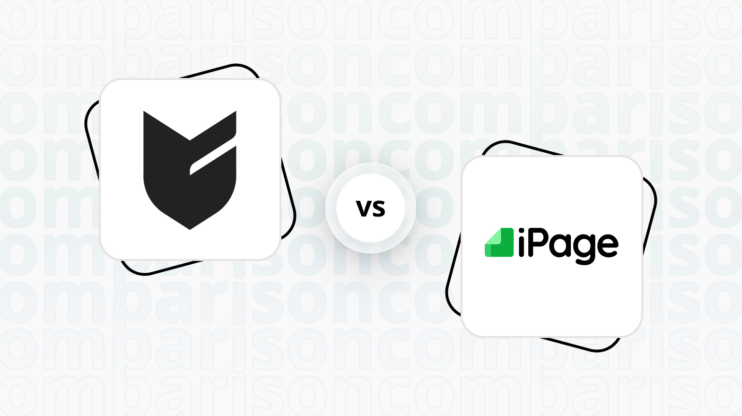Zenfolio vs Web.com: Final verdict
Zenfolio and Web.com both offer unique strengths, catering to different user needs.
-
Zenfolio (Overall Grade: 6.4/10)
is tailored for photographers and visual artists, providing specialized tools for showcasing and selling their work. It excels in design functionalities and ecommerce features specific to photography, making it an ideal choice for professionals in this field. Zenfolio’s robust security measures and intuitive website editor further enhance its appeal, though it could benefit from more comprehensive learning resources and faster loading times. When comparing Zenfolio vs Web.com, Zenfolio stands out for its niche focus and specialized capabilities. -
Web.com (Overall Grade: 5.8/10)
offers a more general website building platform with a strong emphasis on ease of use and affordability. It provides a wide range of templates and robust customization tools, making it suitable for various industries. Web.com excels in AI capabilities, marketing features, and customer support, offering a comprehensive set of tools for users looking to establish or enhance their online presence. In the Zenfolio vs Web.com comparison, Web.com is a versatile option for users seeking a user-friendly platform with broad functionality.

|

|
|
|---|---|---|
|
Design functionalities & templates |
6.8 |
6.4 |
|
Ease of use |
6.3 |
6.4 |
|
Ecommerce |
6.3 |
6.3 |
|
Website Editors |
7.6 |
6.6 |
|
Product testing options |
8.4 |
0.2 |
|
Price |
8.2 |
7.4 |
|
Hosting quality |
5.7 |
5.9 |
|
Website speed optimization |
5.2 |
5.8 |
|
Plugins and integrations |
6.5 |
6.7 |
|
Marketing features |
6.1 |
7.0 |
|
Customer support |
6.7 |
7.3 |
|
Security |
8.0 |
7.6 |
|
AI capabilities |
2.4 |
7.3 |
|
User Management |
2.8 |
5.2 |
Which one is the best for ecommerce: Zenfolio or Web.com?
 6.3
6.3
 6.3
6.3
Verdict
: Zenfolio and Web.com both score equally in ecommerce, but they cater to different audiences. Zenfolio is tailored for photographers and visual artists, while Web.com offers a more general ecommerce platform suitable for various businesses.
-
Zenfolio
: Zenfolio is designed specifically for photographers and visual artists, offering specialized ecommerce features for selling prints, digital downloads, and other products. It includes multiple currency support, discount coupons, order management, gift certificates, and tax management. This makes Zenfolio an excellent choice for creatives looking to showcase and sell their work online. -
Web.com
: Web.com provides a general ecommerce platform with features like product listing, marketing tools, shipping options, and payment gateway integration. It is suitable for a variety of businesses looking to establish an online presence. While it may not have the specialized tools that Zenfolio offers for photographers, it provides a solid foundation for general ecommerce needs.
Which one is the best for informational and business websites?
 6.9
6.9
 6.5
6.5
Verdict
: Zenfolio and Web.com both offer unique advantages for informational business websites, but Zenfolio slightly edges out Web.com with a score of 6.9 compared to Web.com’s 6.5. Zenfolio’s specialized features for photographers make it a strong contender for visually driven informational sites, while Web.com provides a more general approach suitable for a wider range of industries.
-
Zenfolio
: Zenfolio is tailored for photographers and visual artists, offering elegant, mobile-friendly templates and integrated e-commerce capabilities. Its focus on showcasing and selling visual work makes it ideal for professionals in the photography industry. However, its specialized nature may limit its versatility for other types of informational websites. -
Web.com
: Web.com provides a user-friendly platform with drag-and-drop functionality and a wide selection of templates. It emphasizes mobile responsiveness and includes SEO tools to improve online visibility. While it may not offer the same level of customization as Zenfolio for visual artists, its broader range of features makes it suitable for various industries looking to establish or enhance their online presence. When comparing Zenfolio vs Web.com, Web.com is a solid choice for those seeking a versatile and easy-to-use website builder.
Zenfolio vs Web.com: Detailed comparison
Design functionalities & templates
Design FunctionalitiesRepresents how well each platform allows for creative design and customization of websites.Score Components:
- Template Variety (30%): Range and quality of design templates.
- Customization (30%): Flexibility and options for design alterations.
- User Interface (20%): Ease and intuitiveness of the design process.
- Responsiveness (10%): Adaptability to different devices and screen sizes.
- Innovation (10%): Unique design features and tools.
 6.8
6.8
 6.4
6.4
🏆
Winner: Zenfolio.
If you’re a photographer or visual artist looking for a platform that offers extensive customization options and photography-specific features, Zenfolio is the preferred choice.
Zenfolio offers a variety of customizable templates and features specifically tailored for photographers, with a focus on showcasing and selling their work. While it provides several customization options, including blocks for different layouts and styles, it may not offer as much versatility outside of photography-specific needs.
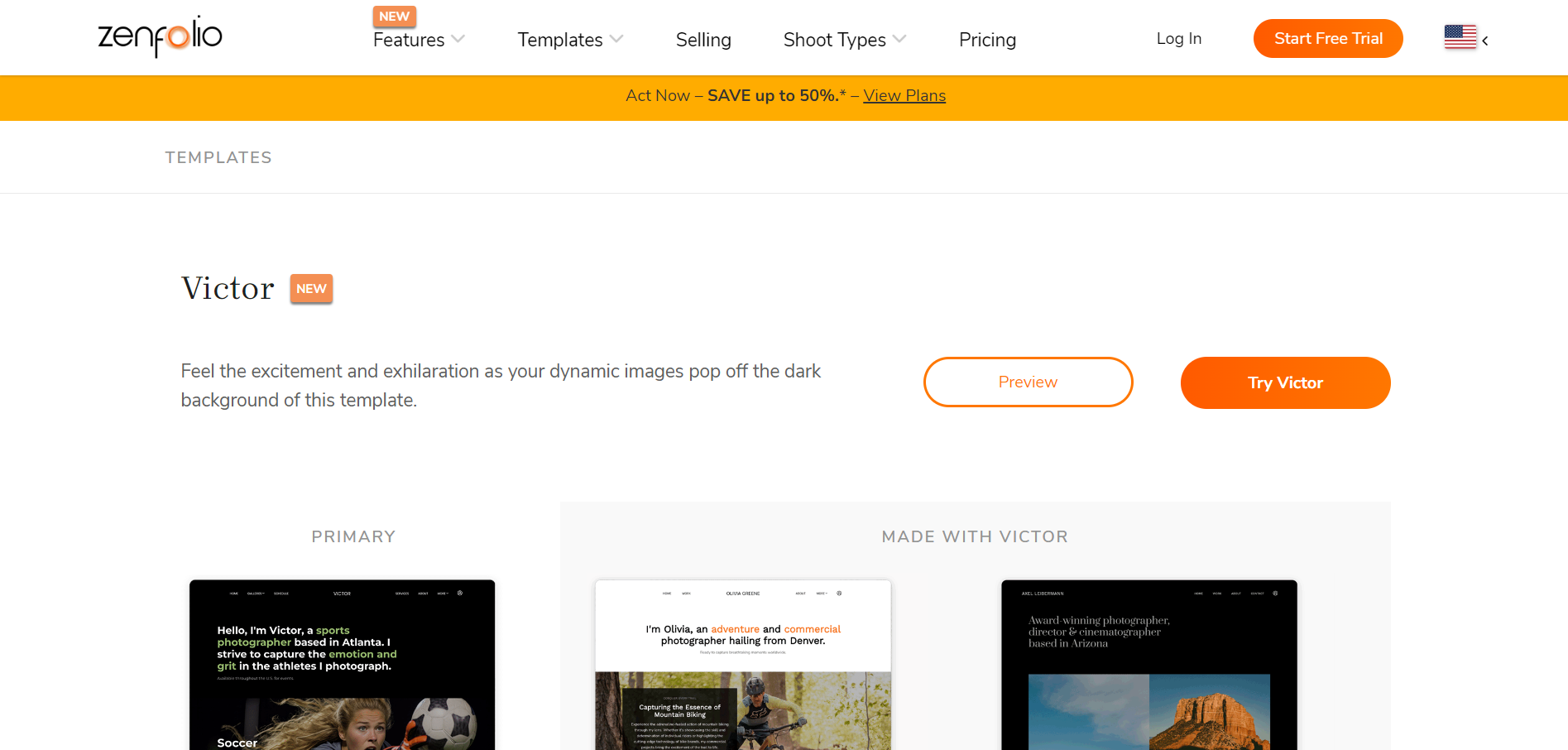
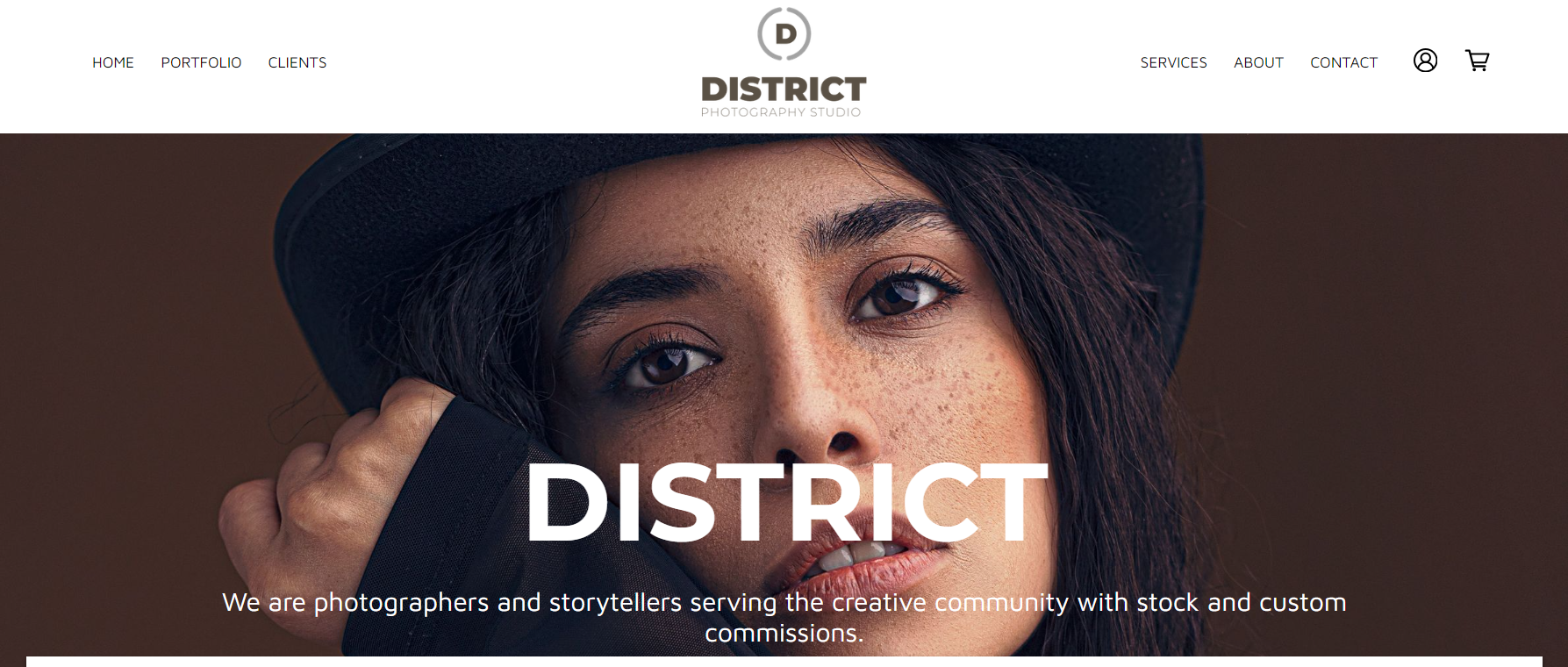
Compared to Zenfolio, Web.com offers over 100 website templates designed to cater to a broad spectrum of industries and personalization needs. These templates are structured to be straightforward in customization, allowing users to easily adapt their chosen designs to suit their unique brand identity through the platform’s editor.
Get a head start on website creation with AI
Create a custom website tailored to your business needs 10X faster with 10Web AI Website Builder!
Ease of use
Ease of useReflects the platform’s overall user-friendliness.Score
Components:
- Learning curve (40%): Quickness and ease of getting started.
- Interface design (30%): Simplicity and intuitiveness of layout.
- User guidance (20%): Quality of tutorials and support.
- Flexibility (10%): Adaptability to various user skills.
 6.3
6.3
 6.4
6.4
🏆 Winner: Web.com
. With a score of 6.4, Web.com slightly edges out Zenfolio, which scored 6.3. Web.com is recognized for its wide range of templates and robust customization tools, catering to various industries and preferences. Zenfolio, on the other hand, offers a specialized platform for photographers, focusing on easy setup and customization for photo portfolios.
Learning Resources
🏆 Winner: Web.com
. Web.com offers a range of AI-powered tools and a comprehensive knowledge base to assist users in building and managing their websites. Zenfolio’s resources are somewhat limited, with users expressing a desire for more comprehensive learning resources.
For ecommerce
EcommerceMeasures the platform’s effectiveness in supporting online business activities.Score Components:
- Ecommerce themes and templates (20%): Variety and design of templates.
- Product management (25%): Ease of managing and organizing products.
- Payment options (25%): Variety and convenience of payment methods.
- Ecommerce features (20%): Features for managing an ecommerce store.
- Integration (10%): Compatibility with external e-commerce tools and services.
 6.3
6.3
 6.3
6.3
Both Zenfolio and Web.com have similar scores for ecommerce, indicating that they offer comparable features for online selling. However, Zenfolio is specifically designed for photographers and visual artists, offering specialized ecommerce features for selling prints, digital downloads, and other products. On the other hand, Web.com provides a more general ecommerce platform suitable for a variety of businesses.

|

|
|
|---|---|---|
|
Ecommerce themes and templates |
7.0 |
5.5 |
|
Product page customization |
7.2 |
6.0 |
|
Payment processing and commissions |
6.5 |
6.5 |
|
POS capabilities |
3.0 |
4.0 |
|
Payment gateways |
6.8 |
7.0 |
|
Product numbers |
5.0 |
5.0 |
|
Additional ecommerce features |
6.5 |
6.0 |
Zenfolio ecommerce features:
- Multiple Currency Support
- Discount Coupons
- Order management
- Gift Certificates
- Tax management
Web.com ecommerce features:
- Product listing
- Marketing Features
- Shipping options
- Payment Gateways integration
Ecommerce themes & templates
Zenfolio provides customizable website templates with integrated e-commerce features for photographers, designed to showcase and sell their work across various genres. These templates include essential online selling tools such as secure payment options, product management, and marketing integrations, making it an all-in-one platform for photographers aiming to display and market their creations effectively.
Web.com offers around 15 ecommerce templates designed to help businesses quickly launch and customize their online stores, emphasizing ease of use, cost-effectiveness, and professional design. These templates are compatible with Web.com’s website builder, facilitating straightforward customization and integration for digital storefronts.
Product page customization
Zenfolio allows users to detail their product pages with descriptions, images, and options such as size or color. This allows for each product page to be adjusted to clearly display its unique attributes. Placing products in specific galleries or categories helps organize the site and improve navigation. The platform also supports customization in pricing and shipping settings, allowing sellers to cater to various needs effectively.
Web.com’s website builder offers a suite of tools for e-commerce stores, including product category management for organizing inventory and improving navigation, and product listing features for adding detailed product information and images. Users can create and manage product variants to accommodate items with multiple options, enhancing the customer shopping experience.
Payment processing
Zenfolio supports Stripe and PayPal for payment processing, integrating them seamlessly into its platform designed for photographers to sell their work online. The platform charges a commerce fee of 7% per order (excluding tax and shipping) and a payment processing fee for transactions through Stripe or PayPal.
Web.com facilitates eCommerce activities by supporting popular payment gateways like PayPal, Stripe, and all major debit and credit cards, ensuring a wide array of payment options for customers. Details on transaction commissions, particularly whether Web.com imposes additional fees on transactions processed through these gateways, were not clearly stated in the reviewed sources.
Website Editors
Website EditorsEvaluates the platforms’ website building and editing capabilities.Score Components:
- Customization tools (40%): Range and power of editing features.
- Editor usability (30%): User experience within the editor.
- Design flexibility (20%): Freedom in layout and design changes.
- Update and maintenance ease (10%): Simplicity of updating and maintaining the site.
 7.6
7.6
 6.6
6.6
🏆
Winner: Zenfolio
. Zenfolio, with a score of 7.6, offers an intuitive, no-coding-required website builder tailored for photographers, featuring drag-and-drop customization, a wide array of templates, and a powerful Custom Layout block for personalized designs. Its integrated eCommerce capabilities enable selling both digital and physical photography products, supported by comprehensive security features for protecting photographers’ work. Additionally, Zenfolio provides tools for SEO, marketing, photo and video hosting, client booking, and management, backed by award-winning customer support.
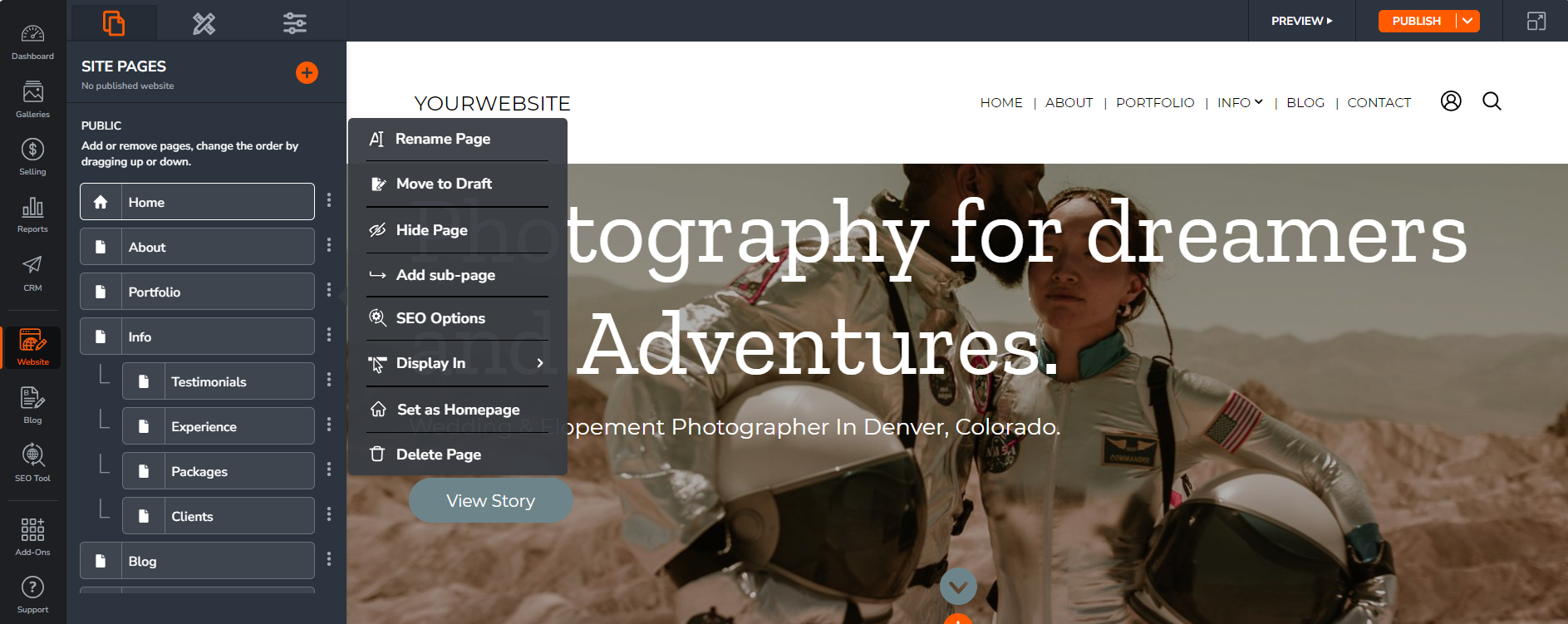
Web.com’s editor, scoring 6.6, offers a user-friendly platform with a variety of templates and a drag-and-drop interface for easy customization, albeit with some creative limitations due to its row-based layout. It supports basic e-commerce capabilities suitable for small businesses, alongside features like analytics, social media integration, and email services. However, for more advanced functionalities like promotional pop-ups, calendars, or comprehensive blogging tools, the platform may fall short unless users are willing to add custom code.
Mobile editor/app
 8.5
8.5
 0
0
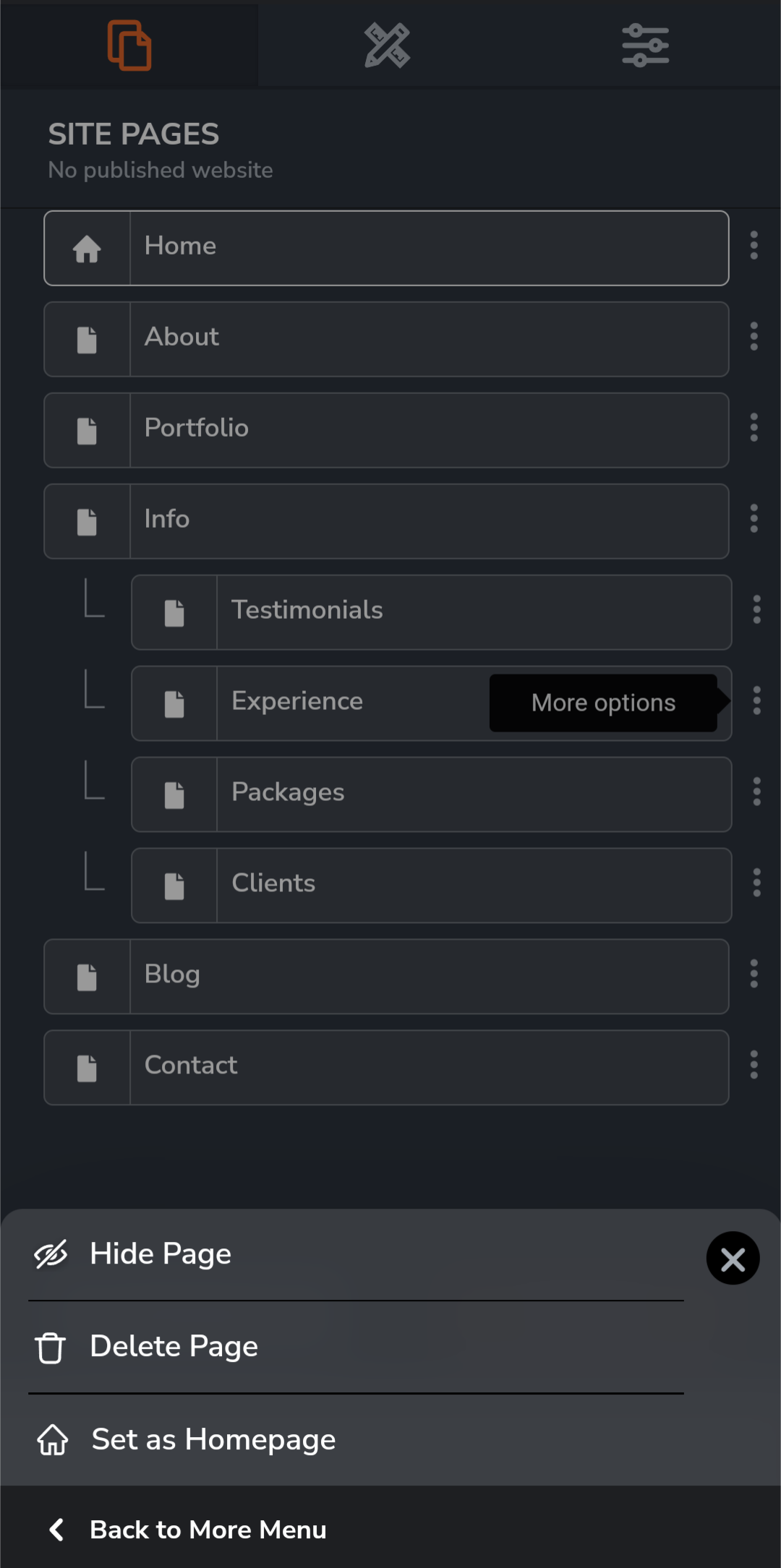
🏆
Winner: Zenfolio
. Zenfolio offers a mobile editor app that allows users to manage their websites and galleries directly from their mobile devices. It includes features for receiving notifications, managing galleries, handling sales-related tasks, and showcasing photos through a client presentation mode. Additionally, the app supports uploading and editing photos, as well as accessing various tools for reports, CRM, bookings, and blog management, although some features may still necessitate desktop use for full functionality.
Web.com, on the other hand, does not have a dedicated mobile editor app, making Zenfolio the clear winner in this category.
Product testing options
Product Testing OptionsAssesses the options for trying out platform features before commitment.Score Components:
- Trial quality (40%): Extent and usefulness of the trial or free version.
- Feature accessibility (30%): How many features are available to test.
- Trial duration (20%): Length of the trial period.
- Ease of transition (10%): Smoothness of moving from trial to paid plans.
 8.4
8.4
 0.2
0.2
Overall Result
:
Zenfolio Wins
. Zenfolio scores 8.4 in product testing options, significantly higher than Web.com’s 0.2. Zenfolio offers a 14-day free trial, during which users can test premium features. Additionally, Zenfolio provides a 30-day money-back guarantee. In contrast, Web.com does not offer a free or trial version, and users cannot test any features before purchasing a plan. Web.com’s money-back guarantee is also significantly shorter, at only 3 days.

|

|
|
|---|---|---|
|
Free Plan |
No | No |
|
Trial Duration |
14 days | No trial available |
|
Testing Premium Features |
During the free trial |
Not possible |
|
Money-Back Guarantee |
30 days |
3 days |
Price
PriceLooks at the cost-effectiveness and value for money of each platform.Score Components:
- Plan value (40%): What each pricing tier offers.
- Transparency and clarity (30%): Clearness of pricing structures.
- Flexibility of plans (20%): Range of options to suit different budgets.
- Hidden costs (10%): Additional expenses not included in the plan.
 8.2
8.2
 7.4
7.4
Zenfolio and Web.com offer different pricing plans with various features. Zenfolio’s plans range from $9 to $40 per month, while Web.com’s plans range from $19.99 to $34.99 per month. Both platforms offer significant discounts for annual billing. Neither platform offers an enterprise plan. Zenfolio has a price score of 8.2, while Web.com has a price score of 7.4.

|

|
|
|---|---|---|
|
$0-$10 |
Portfolio ($9.00/month): Basic entry-level with 15 GB photo storage, HD video, single-page website. Value for price: 6.0 |
No offering at this amount. |
|
$10-$20 |
No offering at this amount. |
Website ($19.99/month): AI-powered Website Builder. Free domain & domain privacy for 1 year. Professional email for 3 months. SSL Certificate for 1 month. 1 hour expert design support. Social & email marketing tools. Value for price: 6.5 |
|
$20-$30 |
PortfolioPlus ($23.00/month): Balanced features with 150 GB photo storage, HD video, single-page website. Value for price: 7.5 |
Website + Marketing ($24.99/month): All features in the Website plan. Enhanced marketing tools. Appointment scheduling. Value for price: 7.0 |
|
$30+ |
ProSuite ($40.00/month): Extensive features for photo and video, multi-page websites, blog, templates, and more. Value for price: 9.0 |
eCommerce ($34.99/month): All features in the Website + Marketing plan. Online store with secure checkout. Sell on multiple marketplaces like Facebook, Instagram, Amazon, eBay, etc. Value for Price: 8.5 |
location. As a result in rare cases the prices displayed here can differ from the ones you see on their
websites.
Hosting quality
Hosting
qualityExamines the reliability and performance of the hosting solutions.Score Components:
- Uptime (40%): Consistency and reliability of website availability.
- Speed (30%): Loading times and performance.
- Bandwidth and storage (20%): Sufficiency of resources provided.
- Data centers (10%): Quality and distribution of hosting infrastructure.
 5.7
5.7
 5.9
5.9
🏆
Winner: Web.com
Both Zenfolio and Web.com offer hosting services, but Web.com edges out with its unlimited storage and daily backups. Neither platform provides information about their uptime statistics or data center locations, making it difficult to compare their reliability and performance. However, Web.com’s shared hosting and daily backups provide a slight advantage over Zenfolio’s cloud hosting and manual backup option.

|

|
|
|---|---|---|
|
Do they offer hosting? |
Yes, with 15GB to unlimited storage and manual backup option |
Yes, with unlimited storage and daily backups |
|
Type of hosting: |
Cloud Hosting |
Shared hosting |
|
Uptime: |
Not disclosed |
Not disclosed |
|
Uptime Guarantee: |
No |
No |
|
Data Centers: |
Not disclosed |
Not disclosed |
Website Speed Optimization
Website Speed OptimizationEvaluates optimization of website loading timesScore Components:
- PageSpeed Score (30%): Google’s score indicating performance optimization.
- Loading Time (30%): The average time until a website is fully interactive.
- Mobile Optimization (15%): Optimization effectiveness for mobile devices.
- Resource Optimization (15%): Optimizing images, scripts, and other heavy resources.
- CDN Usage (10%): Use of CDN to enhance speed across geolocations.
 5.2
5.2
 5.8
5.8
🏆 Winner: Web.com
Both Zenfolio and Web.com prioritize website performance and page speed, but Web.com has a slight edge due to its more comprehensive speed optimization strategies.

|

|
|
|---|---|---|
|
Focus |
Mobile responsive design |
Mobile Optimized design, Code Minification, Caching, Image Optimization |
|
Performance Tools |
Not specified |
Not specified |
|
Key Strategies |
Mobile responsive design |
Mobile Optimized design, Code Minification, Caching, Image Optimization |
|
Load Times |
Varies depending on optimization and website complexity |
Varies depending on optimization and website complexity |
|
Page Speed Scores Range |
Not specified |
Not specified |
|
Core Web Vitals Improvement |
Not specified |
Not specified |
Web.com’s approach to enhancing site speed includes mobile-optimized design, code minification, caching, and image optimization. These strategies help to reduce load times and improve the overall performance of websites built on the platform. However, specific load times and PageSpeed scores vary depending on the level of optimization and the complexity of the website.
Zenfolio, on the other hand, focuses on mobile responsive design as its primary strategy for speed optimization. This ensures that websites built on Zenfolio perform well on mobile devices, which is crucial given the increasing prevalence of mobile web browsing. However, like Web.com, Zenfolio’s load times and PageSpeed scores can vary depending on the level of optimization and the complexity of the website.
Neither Zenfolio nor Web.com provide specific information on their Core Web Vitals improvements. As such, it’s difficult to compare the two platforms in this regard. However, given Web.com’s more comprehensive approach to speed optimization, it is the winner in this category.
Get a head start on website creation with AI
Create a custom website tailored to your business needs 10X faster with 10Web AI Website Builder!
Plugins and integrations
Plugins and integrationsMeasures the range and effectiveness of additional plugins and integrations.Score Components:
- Variety of options (40%): Range of available add-ons.
- Integration smoothness (30%): Ease of integrating plugins into the site.
- Quality of plugins (20%): Functionality and reliability of the options.
- Custom integration capabilities (10%): Support for custom or third-party integrations.
 6.5
6.5
 6.7
6.7
🏆 Winner: Web.com.
With a score of 6.7, Web.com slightly edges out Zenfolio, which scores 6.5. Web.com offers a suite of plugins and integrations that enhance its basic functionality, enabling advanced eCommerce features, comprehensive SEO tools, enhanced social media integration, and specialized functionalities like appointment scheduling. Zenfolio, on the other hand, offers a focused set of plugins and integrations specifically designed for photographers, including WordPress plugins for embedding photos, a Lightroom Classic plugin for direct photo uploads and management, and the ability to embed forms via services like Jotform. While both builders offer valuable plugins and integrations, Web.com’s broader range of functionalities gives it a slight advantage.
Marketing Features
Design FunctionalitiesRepresents how well each platform allows for creative design and customization of websites.Score Components:
- Template Variety (30%): Range and quality of design templates.
- Customization (30%): Flexibility and options for design alterations.
- User Interface (20%): Ease and intuitiveness of the design process.
- Responsiveness (10%): Adaptability to different devices and screen sizes.
- Innovation (10%): Unique design features and tools.
 6.1
6.1
 7.0
7.0
🏆
Overall Winner: Web.com
. Web.com has a slightly higher score in marketing features, indicating a more comprehensive set of tools for SEO, email marketing, blogging, social media integration, analytics and reporting, and ads and promotions. However, Zenfolio also offers a solid set of marketing tools, particularly for photographers and visual artists.

|

|
|
|---|---|---|
|
SEO Tools |
Yes, but limited |
Yes |
|
Email Marketing |
Yes |
Yes |
|
Blogging |
Yes, on higher plans |
Yes |
|
Social Media Integration |
Yes |
Yes |
|
Analytics and Reporting |
Yes, basic built-in analytics tools |
Yes, basic website analytics |
|
Ads and Promotions |
Yes |
Yes |
Customer Support
Customer supportEvaluates the quality and availability of support options.Score Components:
- Response time (40%): Speed of support responses.
- Support quality (30%): Effectiveness and helpfulness of the support.
- Availability (20%): Range of support channels (phone, chat, email).
- Resource richness (10%): Quality of self-help and educational materials.
 6.7
6.7
 7.3
7.3
🏆 Winner: Web.com
. In the comparison of Zenfolio vs Web.com, Web.com takes the lead with a higher customer support score of 7.3 compared to Zenfolio’s 6.7. Web.com offers 24/7 support through email, live chat, and phone, ensuring users can get help whenever they need it. This round-the-clock availability is a significant advantage for users who may encounter issues at any time.
Zenfolio, on the other hand, provides customer support through email 365 days a year, LiveChat from Monday to Thursday, and phone support for Advanced plan subscribers during specific hours. While Zenfolio’s support is comprehensive, the limited availability of live chat and phone support may be a drawback for some users. However, Zenfolio does offer a rich Support Center with self-help resources, including articles and video tutorials, which can be very helpful for troubleshooting common issues.
Security
SecurityLooks at the platforms’ security measures and data protection.Score Components:
- Data protection (40%): Safeguards for user and customer data.
- SSL and encryption (30%): Implementation of secure connections.
- Compliance (20%): Adherence to industry security standards.
- Regular updates (10%): Frequency of security updates and patches.
 8.0
8.0
 7.6
7.6
🏆
Winner: Zenfolio
. Zenfolio’s security measures are robust and tailored to the needs of photographers and visual artists. They offer SSL encryption for all websites, watermarking to protect users’ work, password-protected galleries, and cloud backup for additional data protection. Zenfolio also limits third-party access to personal data and adheres to data protection rights.
Web.com also offers a range of security measures, including website staging environments, email solutions, and a partnership with SiteLock Security for cloud-based security services. However, Zenfolio’s specialized security features for photographers and visual artists give it an edge in this comparison.
AI Capabilities
AI capabilitiesMeasures the effectiveness of AI-driven features and tools.Score Components:
- Automation efficiency (40%): Impact of AI on streamlining processes.
- Personalization (30%): AI-driven customization for users or customers.
- AI-Assisted design (20%): Role of AI in website design and functionality.
- Data analysis (10%): Use of AI in interpreting user data and analytics.
 2.4
2.4
 7.3
7.3

|

|
|
|---|---|---|
|
AI Website Builder |
|
Web.com offers an AI website builder |
|
AI Ecommerce Features |
Zenfolio offers PhotoRefine.ai for managing photo collections |
Web.com offers personalized product recommendations, automated inventory management, customer service chatbots, and insightful data analysis tools |
|
AI Content Generation |
|
Web.com offers an AI Writer for content creation |
|
Additional AI Features |
|
Web.com offers the AI Domain Generator and AI Logo Builder |
🏆 Winner: Web.com
. Web.com, with a score of 7.3, offers a wider range of AI capabilities compared to Zenfolio, which has a score of 2.4. Web.com’s AI capabilities include an AI website builder, AI ecommerce features, an AI Writer for content creation, and additional AI features like the AI Domain Generator and AI Logo Builder. These features make it easier for users to create and manage their websites, regardless of their technical skills.
User Management
User ManagementAssesses the platforms’ capabilities in managing user roles, permissions, and accessibility.Score Components:
- Role Customization (40%): Flexibility in creating and defining user roles and
permissions. - Ease of Management (30%): User interface and tools for managing users.
- Access Control (20%): Effectiveness of access control measures for different user
levels. - Scalability (10%): Ability to manage a growing number of users efficiently.
 2.8
2.8
 5.2
5.2
🏆 Winner: Web.com
. Zenfolio and Web.com have different approaches to user management.
- Zenfolio only allows one user to edit and manage a website.
- Web.com allows multiple user accounts, however, the platform does not specify how many accounts are supported.
Web.com User Roles and Access Levels:
| Role | Description | Access Highlights |
|---|---|---|
| Primary | The main account holder or primary user. | Edit primary user info Purchase products Manage and renew products and services |
| Admin | Users with administrative privileges besides the primary. | Edit payment information Add/Edit/Delete user roles Manage and renew products and services Edit WHOIS Admin and Tech user info |
| Tech | Users with technical responsibilities. | Manage and renew products and services Edit WHOIS Admin and Tech user info |
Additional Features

|

|
|
|---|---|---|
|
SSL Certificate |
|
|
|
Custom Domain |
|
|
|
Free Custom Domain Included |
|
|
|
International Domains |
|
|
|
Mobile Responsive |
|
|
|
Page Speed |
|
|
|
Website Builder Mobile App |
|
|
|
Convert a Website To An App |
|
|
|
Website Analytics |
|
|
|
Multilingual Sites |
|
|
|
Multiple Users |
|
|
Zenfolio vs Web.com: User Feedback
Users appreciate Zenfolio for its elegant and affordable site/portfolio designs, highlighting the platform’s suitability for photographers looking to showcase and sell their work online. The Starter plan is praised for its value, though some users express a desire to upgrade to the Pro plan for its enhanced client interaction features and customizable marketing tools. Criticisms include dissatisfaction with the platform’s handling of photo albums and a desire for more privacy and faster loading times. Overall, Zenfolio is valued for its ability to organize and share professional photographs and files, despite some navigational and performance issues.
Web.com, while not reviewed on G2, offers a platform aimed at users without coding expertise, providing drag-and-drop functionality and a selection of pre-built templates for easy website creation and customization. It emphasizes mobile responsiveness and includes eCommerce capabilities, SEO tools, and analytics features, catering to both novice and seasoned users looking to establish or enhance their online presence.
The making of this blog
We followed a clear, step-by-step process to write and research this article.
Zenfolio vs Web.com: FAQ
Which platform is better for photographers, Zenfolio or Web.com?
Can I sell products on both Zenfolio and Web.com?
Which platform offers better customer support, Zenfolio or Web.com?
How do Zenfolio and Web.com compare in terms of AI capabilities?
Which platform is more user-friendly for beginners?
Are there any free plans available for Zenfolio or Web.com?
Which platform is better for SEO and marketing features?
Can I manage multiple users on Zenfolio and Web.com?
What security features do Zenfolio and Web.com offer?
Which platform is more affordable?










